Nashwaak Watershed Association | Forest Stewardship
Managing Your Forest
nashwaak forest stewardship project
Learn. share. manage. protect.
Since 2021, the Nashwaak Watershed Association has offered free visits from foresters to private forest owners in the watershed. We discuss the owner’s goals for their forest, hear their questions, and provide recommendations for achieving their goals while also maximizing the ecosystem services provided by their forests – things like wildlife habitat, resilience to climate change and protecting aquatic ecosystems. Read on to find out some of the most common recommendations we have been providing to forest owners.
Encouraging Wildlife Habitat | Protecting Aquatic Habitat | Adapting to Climate Change | Tending & Regenerating | Restoring Mature Forest | Pests & Invasive Species | Harvesting Wood | Long Term Planning
Interested in a site visit?
Book a visit to your forest by contacting us at forest@nashwaakwatershed.ca.
Encouraging Wildlife Habitat
Older forests provide important habitat features that younger forests lack. In older forests, living trees of various ages provide multiple layers of forest canopy. Dead wood also provides important habitat, where standing dead trees provide food and nesting sites and fallen dead wood provides habitat for small animals and insects, lichens and mosses. Fallen logs also hold moisture, release nutrients, and provide superb growing conditions for tree seedlings.
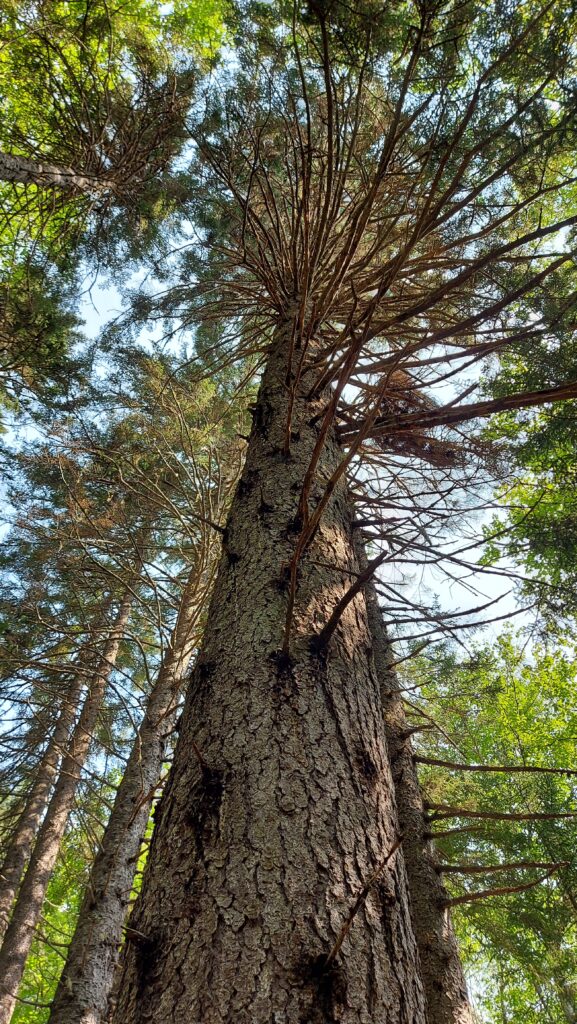
Leave a Legacy
To provide much needed habitat for a range of wildlife, it is important to retain large trees (legacy trees) and allow them to live out their full life cycle, permitting them to die naturally and decompose in the forest. There should be around 8 of these trees retained per hectare, ideally of > 30 cm diameter. Choose mature, shade-tolerant species to retain, if possible. Examples of good legacy trees include yellow birch, white pine, red oak, and poplar (poplar is not a long-lived tree, but it is favoured by many cavity nesters). These species all also provide important sources of food for wildlife. Removing competing trees growing close to legacy trees will give the legacy trees more room to grow and thrive, and will transition a young forest to an older forest at a quicker pace.
Snag Some Habitat
A healthy forest should also have a number of trees with cavities for wildlife, as well as standing dead trees (snags) – around 8 per hectare. If this proportion of deadwood doesn’t already exist in your forest, it can be encouraged through practices like “girdling” of less desirable species. Keeping intact forest around deadwood can further protect this wildlife habitat. If harvesting takes place, woody debris can be left behind to create additional wildlife habitat like the “grouse condo” shown below.
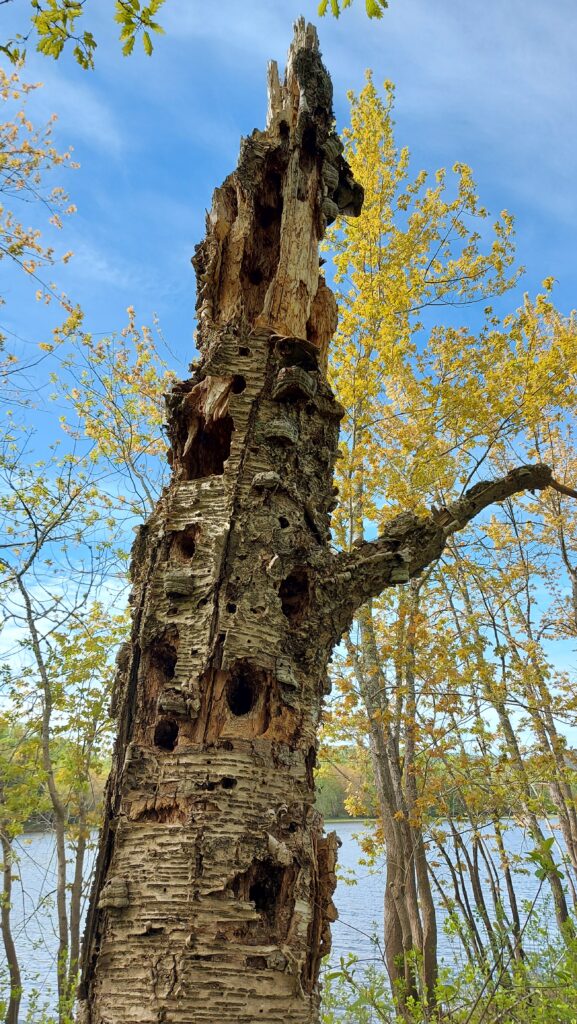
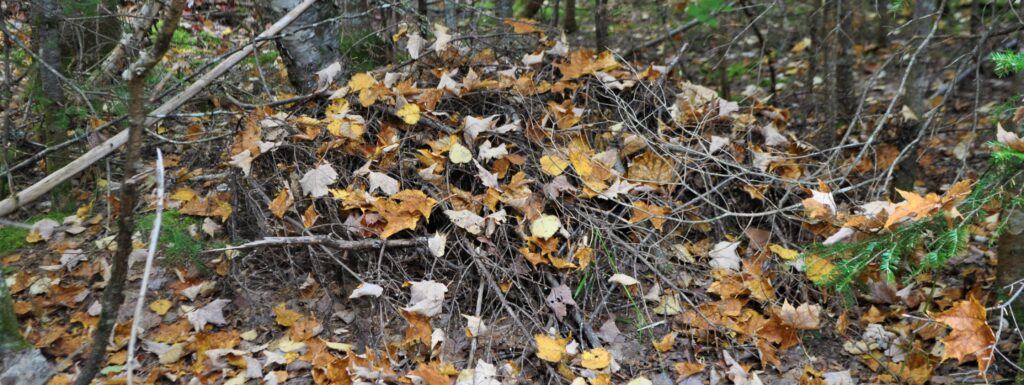
Protecting Aquatic Habitat
Forests contribute to healthy aquatic ecosystems. Trees bordering rivers and streams provide cooling shade, water filtration, food, habitat and reduce flooding. Fallen trees, dead wood and leaf litter provide important barriers and slow down the passage of water. Surface water travelling down to a river or stream then has the time to be purified before it enters the river, reducing sedimentation.
Soil disturbance (from harvesting or other work in a forest) and its subsequent release into streams and rivers destroys good habitat by putting down a layer of silt over spawning beds, reducing the ability of fish to feed and increasing nutrients in the river (which can lead to harmful algae blooms and poor water quality). Control of all mechanical operations adjacent to springs and watercourses, including ditches, is critical to the protection of aquatic habitat. If work or activity must take place in the forest (e.g., road upgrades) it should be performed during the driest time of the year or when the ground is frozen, and measures should be taken to avoid silt entering the watercourse.
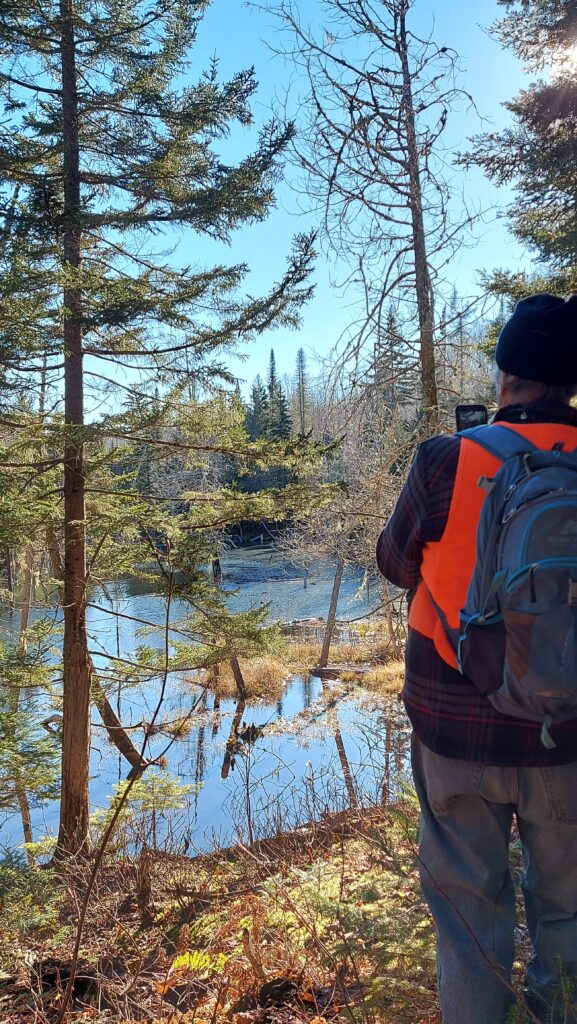
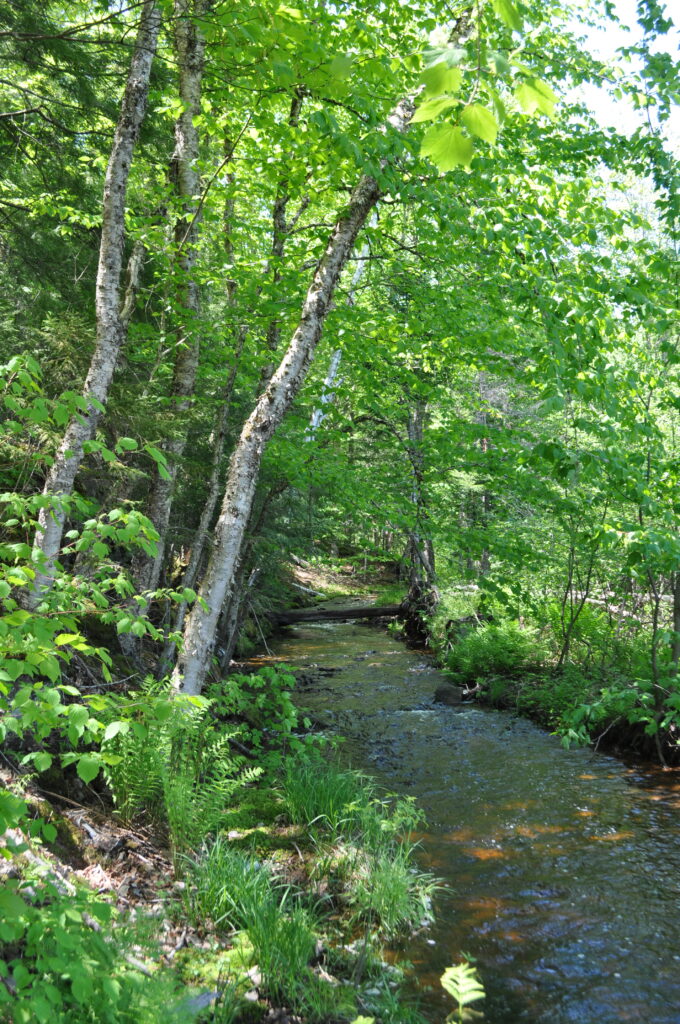
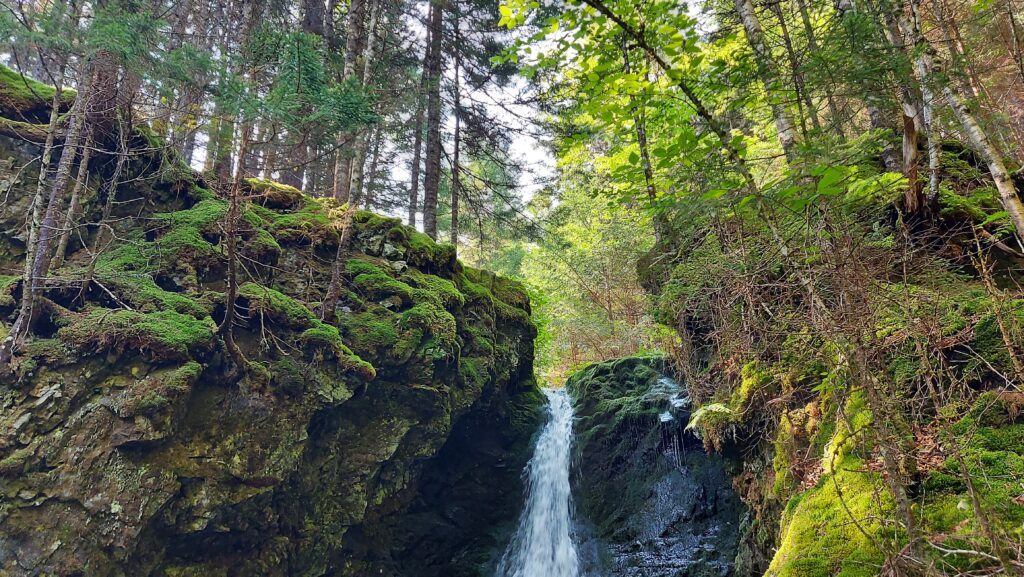
If you plan to harvest trees using machinery, it is important to:
- Identify and mark off wet areas as no track zones.
- In wet soils, only harvest in the winter.
- Remediate any rutting or signs of erosion immediately.
- Attempt to have continuous canopy coverage on as much of the woodlot as possible, especially near any watercourses. Forest owners are required to maintain a 30 m buffer of forest on either side of a watercourse in New Brunswick. However, preserving more forest surrounding watercourses provides added protection for aquatic habitats.
- Exceed all guidelines of the Watercourse and Wetland Alteration Regulations (consulting a competent and certified professional is a good idea). You will likely require a Watercourse And Wetland Alteration permit if you plan to make any alterations to the watercourse and feeder streams on your property.
It is important to protect ponds and vernal pools (seasonal pond areas) in your forest. These are important wildlife habitat (e.g., vernal pools are attractive to wood frogs and salamanders) and should not be disturbed.
Adapting to Climate Change
The changing climate will have a great impact on the forests in our region, but there are things forest owners can do to help their forests adapt. A number of species that are more closely associated with the boreal forest, like balsam fir, white spruce, white birch, and aspen, are predicted to decline in the next fifty years and beyond. Many forests in New Brunswick, including many stands we have visited, are now dominated by balsam fir and white spruce, as a result of intensive past forestry practices.
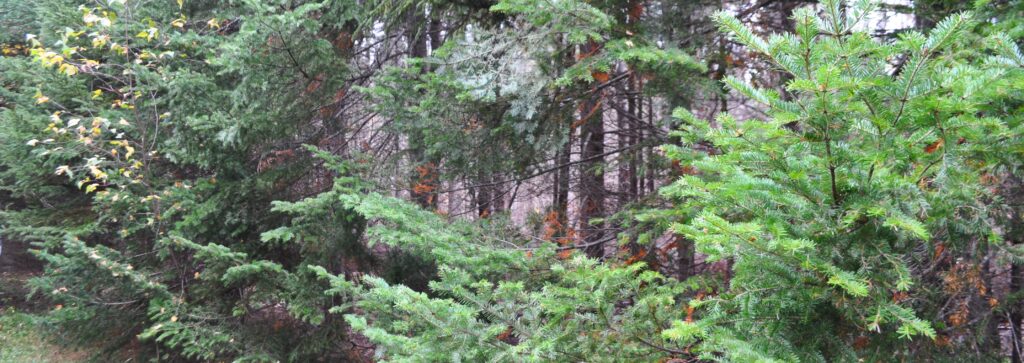
In many situations, we have been recommending that forest owners:
- Decrease the composition of short-lived, non-climate resilient species (e.g., balsam fir, white spruce, grey/white birch), and
- Increase the abundance of shade tolerant, climate resilient, long-lived species (e.g., red maple, white pine, red oak, yellow birch, red spruce, hemlock, sugar maple).
This can be done in several ways, as described in the next section.
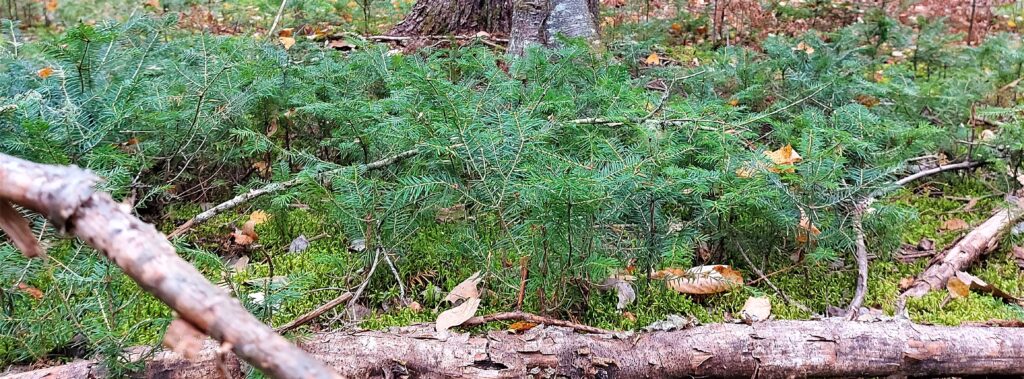
Tending and Regenerating
For stands that are dominated by undesirable (non-climate-resilient) species, these can be thinned to create gaps for regeneration or proliferation of more favourable species. In some stands, the individuals of the desired species may already be present and vigorous in the stand, and in others these will need to be introduced.
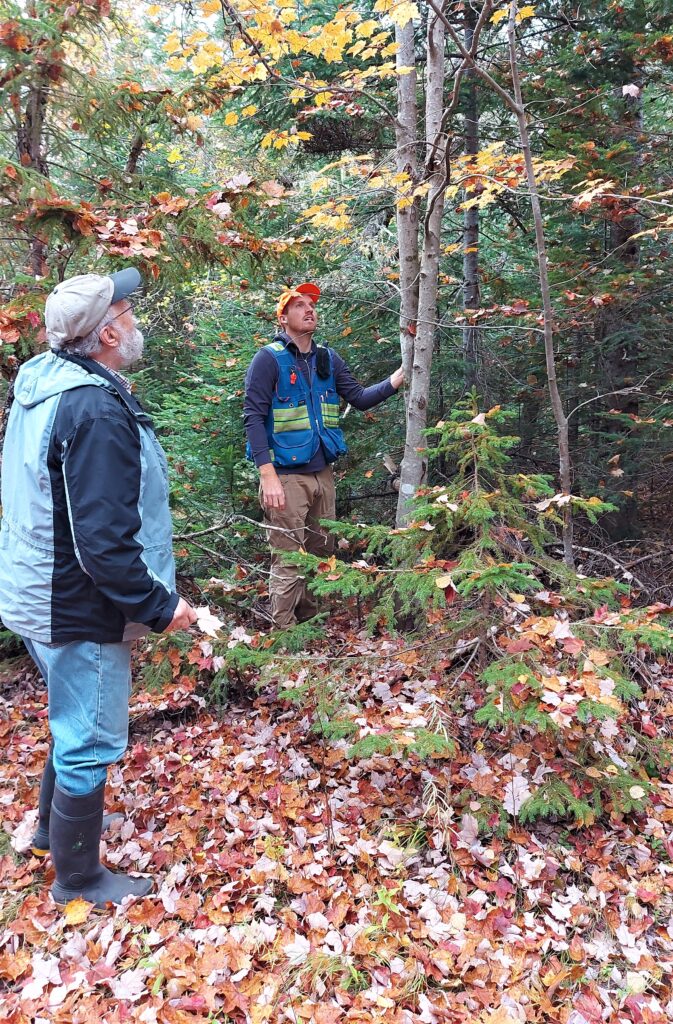
Tend What You Have
In cases where the desirable species are already growing, you simply help the most desired trees access sunlight and eventually gain a competitive canopy position. At the same time, you decrease the presence and competitiveness of undesirable trees.
An example of this might be when balsam fir trees (not climate resilient) are encroaching on the canopy and blocking growing space/light from a neighbouring, vigorous red maple. You could remove the balsam fir trees from three sides of the red maple crown. In other words, you are thinning the stand with red maple as the retention species and balsam fir as the removal species.
It is less important and, in some cases, not advisable to bother thinning trees that are below the canopy and aren’t in direct competition with the crown of the retention trees – this is called thinning from below, and doesn’t have much (if any) positive ecological impact. A good practice is to stand at the base of the retention tree and look directly up the trunk of the tree at the crown – this perspective will allow you to determine what must be removed. It can be hard to remove (fell) trees without damaging the retention trees, so target thinning in the fall/winter when the bark is harder to damage. Favour vigorous trees with good form when choosing those to retain (e.g., single stem trees rather than stump sprouts, > 30% live crown ratio, and trees without large scars or lower V shaped branching).
Regenerate the Forest
In stands that don’t have an adequate number or distribution of desirable trees, you must focus on regeneration rather than tending. Regeneration can come from seeds produced by mature seed-producing trees from within the stand (natural regeneration), or from seeds or seedling that are brought into the site (artificial regeneration).

To regenerate using seeds from trees that exist in the stand, the stand conditions (light, ground disturbance, timing, etc.) must be made ideal for that species to germinate. This technique can be the cheapest and yield the best results but requires knowledge of the germination requirements for different species. One example of how you might recruit natural regeneration on a woodlot is by making canopy openings with diameters 1 to 1.5 times the length of the surrounding trees (mimicking windthrow). You would then cause some minor duff (moss/needle layer) disturbance to expose the mineral soil and monitor for results. If within one or two growing seasons you do not have desired regeneration, you can try artificial regeneration.
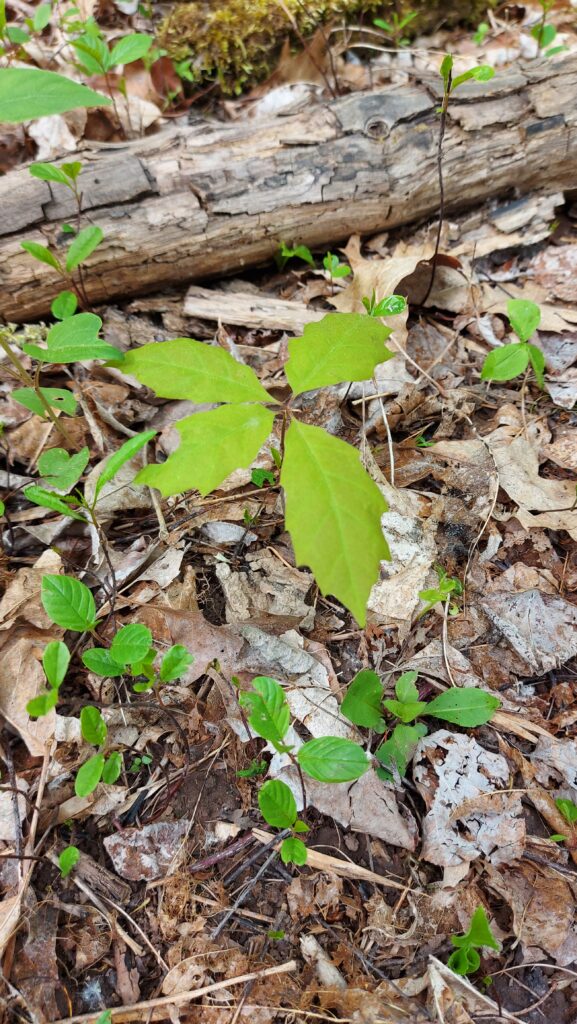
In artificial regeneration, you bring in seeds or seedlings from outside the stand. This could be from seeds you collect (e.g., acorns) or ones you purchase. First you must determine the right seed/seedling for the right site. In some cases, the site will need some preparing to allow the right amount of light and medium to give your seed/seedling the best chance for survival.
Two direct seeding examples include:
- Yellow birch seed – open small tree length gaps in the canopy, disturb the duff layer and scatter the seed. The most ideal time for this would be in the fall before snow fall.
- Red oak acorns- using a piece of rebar or a ½” diameter dowel, poke a hole about 1” into the duff layer, place the acorn in the hole, scuff with boot or hand to cover over (also best done in the fall).
Planting seedlings can have more immediate results than seed, but can be expensive when planting hardwoods, and can be difficult to protect the seedlings from herbivores. Red spruce and white pine seedlings can often be sourced more cheaply than hardwoods (e.g., from marketing boards).
Restoring Mature Forest Characteristics
Many of the recommendations given above will act to “speed up” succession in a forest to restore characteristics of mature or old growth forest – preserving dead and fallen wood, selecting large legacy trees to live out their full lifespan, encouraging multiple ages of trees in a canopy (including adequate regeneration of long-lived, shade tolerant species). All of these recommendations will provide a healthier and more resilient forest that provides ample habitat for wildlife and protects aquatic ecosystems.
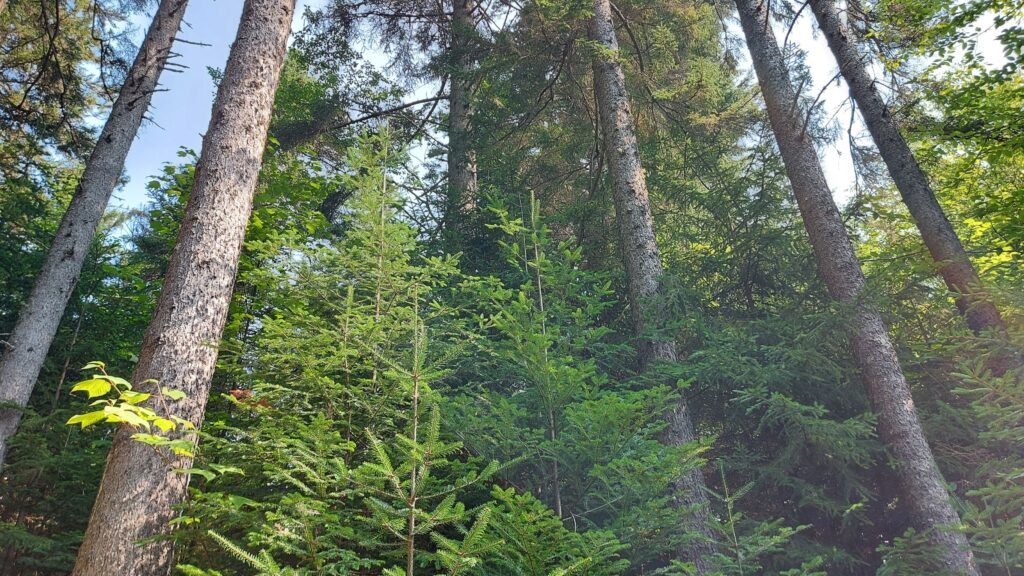
Pests and Invasive Species
Many forest owners are concerned about pests and invasive species that could threaten their forests. Emerald Ash Borer (EAB) is of particular concern at this time. While there is no way to completely prevent the spread of EAB, one way of reducing its chance of entering your forest is refraining from moving firewood. Buying firewood near where it will be used, or cutting your own firewood, greatly reduces the chances of moving EAB or other pests into your forest. If you are purchasing firewood, do not buy wood from other outside ash trees if you have ash growing on your property. Monitor any ash trees in your forest for signs of decline in the crown or D-shaped holes in the trunk. See resources from the NB Invasive Species Council for helpful photos of EAB and its effects (https://www.nbinvasives.ca/eab).
Other pests to consider include hemlock woolly adelgid, beech canker, butternut canker, and white pine weevil. While some of these pests are largely unavoidable, white pine weevil can be deterred by encouraging white pine regeneration in partial shade, rather than full sun conditions. It is also important to note that a small percentage of beech are immune to beech canker, and if your forest contains healthy beech trees (characterized by smooth bark and healthy canopy) these should not be cut. It could be beneficial to encourage regeneration from those disease-free individuals. NWAI invites individuals to collect observations about disease resistant trees in the watershed through an iNaturalist project (https://www.inaturalist.org/projects/nwai-tree-resistance-program), which will assist local nurseries in collecting seed from disease-resistant trees.
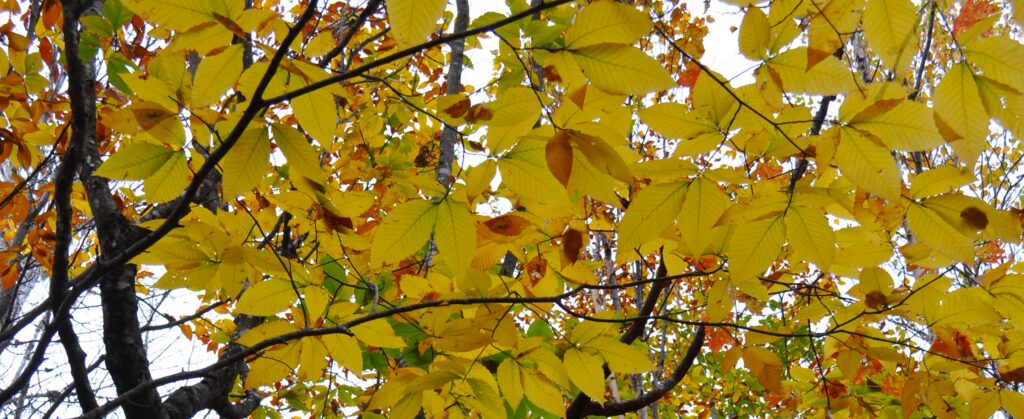
Landowners that are attempting to reforest abandoned fields may have to contend with reed canary grass or other introduced grasses. These plants are quite aggressive, and in the absence of site preparation, mowing around planted trees will be necessary for around 5 years (every 3 weeks of the summer) to ensure that planted trees can outcompete the grasses.
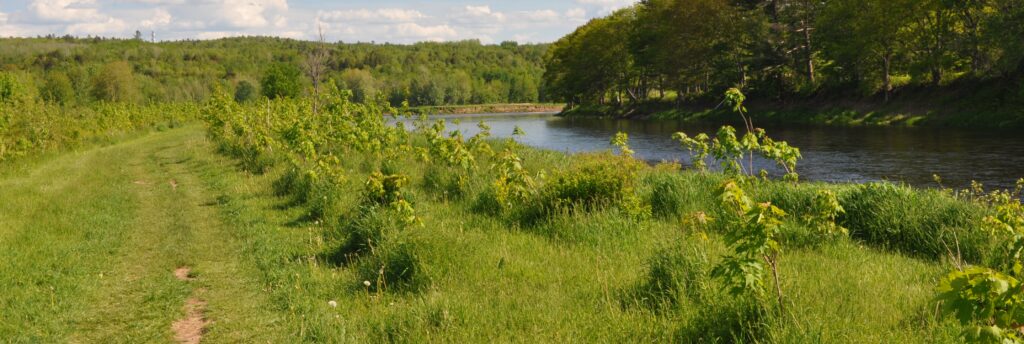
If your forest contains significant road access or ATV trails, you may note invasive species being brought in. Take care when moving machinery onto the property not to transport invasive species (e.g., Japanese knotweed, glossy buckthorn, Norway maple). Such invasive species can also come from fill from an unknown source. The NB Invasive Species Council (https://www.nbinvasives.ca/) is quite happy to take questions and calls from landowners.
Harvesting Wood
Many forest owners are harvesting wood from their forests, either for personal use or to generate income. We offer several considerations below for owners who are planning to harvest their trees.
Firewood
When harvesting firewood for personal use, consider using the stand tending approach described above. If you are satisfied using species like balsam fir for firewood, focus on “releasing” the longer-lived, climate resilient species on your woodlot and providing them with more growing space by removing the nearby balsam fir. This will increase their growth rate and serve to diversify the species composition of your woodlot over time. Retain as many long-lived species as possible, harvesting only what is required and maximizing the amount salvageable wood from blowdowns (while leaving a sufficient deadwood onsite for wildlife). When harvesting maple or other hardwoods for firewood, focus on weaker trees with smaller crowns, or on diseased trees (like most beech).
Mimic Natural Disturbance
When planning a larger harvest, considering trying to mimic the local disturbance regime. The Wabanaki forest does not have natural, large, stand-replacing disturbance. Forest harvesting that creates large gaps in the forest (e.g., clearcutting) does not mimic natural disturbance regimes.
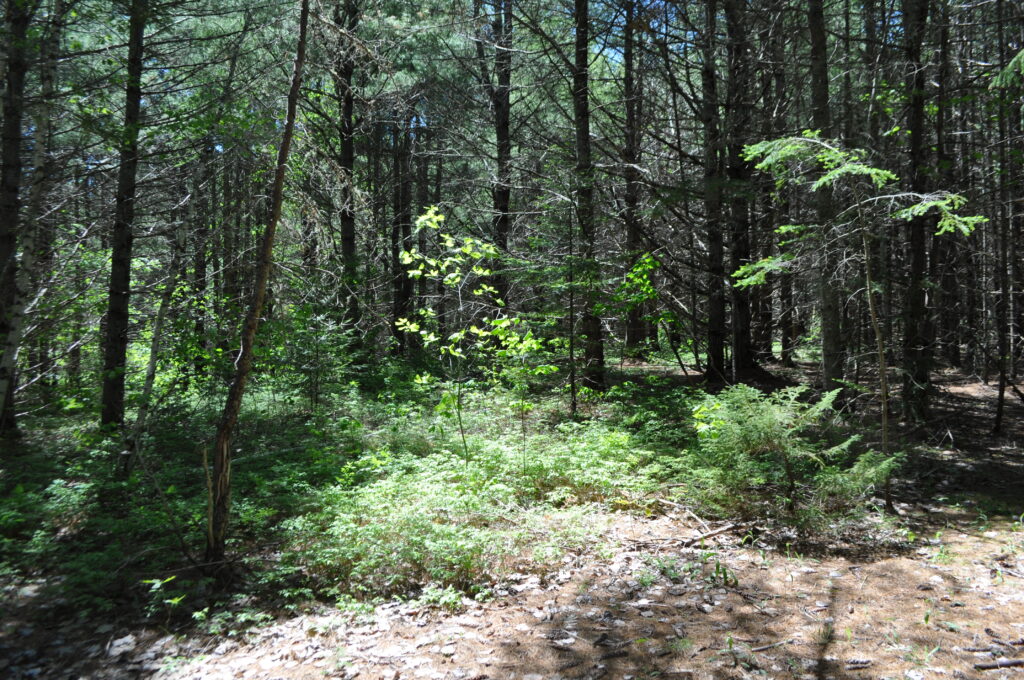
Creating smaller harvested patches is more akin to the impact of natural disturbance and will help to maintain a healthy and natural character to the forest. If the diameter of areas that are cut is less than the height of the surrounding trees, this will encourage desirable shade-tolerant species to regenerate. Removing 1% of the forest canopy per year (or 10% every 10 years) will mimic natural disturbance levels.
It is also important to note that, while it is tempting to cut the best trees, leaving the best will improve the character of your forest and will increase its economic value. Many forests in our region have been continually high-graded (i.e., taking the best, leaving the rest), resulting in poor and unresilient forests. Sustainable harvesting practices are a longer-term approach compared to conventional harvesting. While they may not generate the financial windfall of clearcutting, the long-term financial forecasting is certainly competitive, in addition to the plentiful benefits of stewarding a healthy forest.
Consult an Expert
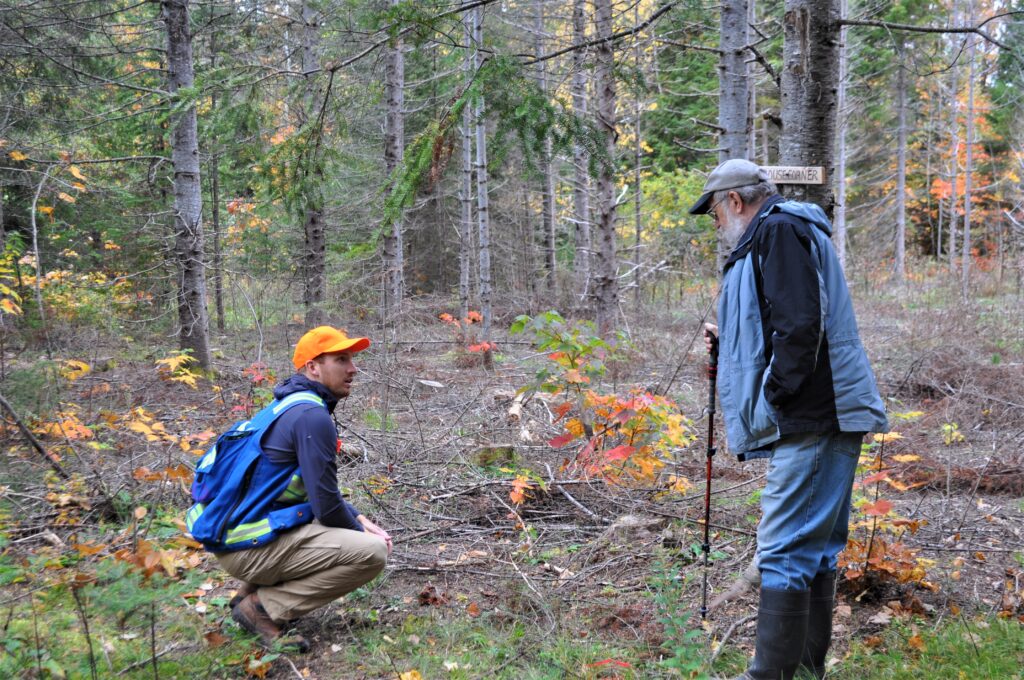
If you are interested in harvesting trees from your property, we encourage you to make contact with your local marking board (e.g., YSC Forest Products Marketing Board). Marketing boards can help to plan a harvest and can help to fund various interventions (e.g., management plans, site preparation and reforestation).
As you plan your harvest, choosing who you work with is important. There is a considerable difference between a logger and a forester: Loggers are generally not trained in managing forests, and foresters are not trained in running machinery to fell, merchandise and deliver forest products. Consult/hire a forester (forest technician, graduate forester, etc.) who has experience in the type of management you wish to complete. If a forester mostly practices in clearcutting, then they may not be suitable to plan/oversee a mixed wood restorative thinning. This is true for the logger as well; it requires different skills sets and equipment to do a quality thinning vs. a clearcut. Some contractors will commit to carrying out ‘selective harvesting,’ but this term come to mean high-grading or harvesting the largest, highest quality trees, leaving degraded forest of poor-quality residual trees. This is not sound forest management, and it is good to clarify what is meant with contractors when they use the term. Be clear about your objectives with the forester/logger. Make as much of it objective, in writing if possible. Consult a trusted professional or third party to help you review a harvest/stumpage contract before signing it. Have financial outcomes tied to the performance of the work. You can include penalties for excessive removals or retention damage.
Long Term Planning
Having an official management plan written by a forester whose values, and expertise align with your objectives is very valuable. It is important to have economic considerations in your management planning. You may be happy to not generate profit from your woodlot, but all interventions require resources. Be realistic about what you can/are willing to do yourself and what you will hire out. Savvy forest managers should be able to leverage forest outputs and public funds to conduct most to the restoration, but there is always a limit to how much can be done without requiring financial inputs.
Having a succession plan for the ownership/stewardship of your woodlot can be just as important as the management you provide today. The majority of forest land buyers are loggers/sawmills looking to produce forest products and generally manage forests quite intensively. If there aren’t people in your family that you feel will steward your land in ways that align with your values, consider an easement or land donation to a trusted organization.
The following links and documents might be of interest in considering the options:
- Conservation Options for New Brunswick Landowners. Nature Trust of New Brunswick.
- Conservation Easements: Questions and Answers for Landowners. Nature Trust of New Brunswick.
- The Future of Your Forest: Selling or Donating Your Forest for Conservation. Community Forests International.
- Gifts of Land, Conservation Agreement, Ecogift Program. Nature Conservancy of Canada.





